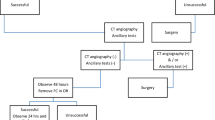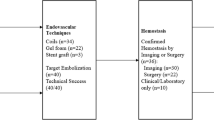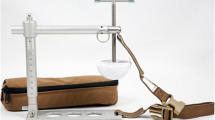Abstract
Background
The foley catheter balloon tamponade (FCBT) has been widely employed in the management of trauma. This study reviews our cumulative experience with the use of FCBT in the management of patients presenting with a penetrating neck injury (PNI).
Methods
A retrospective study was conducted at a major trauma centre in South Africa over a 9-year period from January 2012 to December 2020. All patients who presented with a PNI who had FCBT were included.
Results
A total of 1581 patients with a PNI were managed by our trauma centre, and 44 (3%) patients had an FCBT. Of the 44 cases of FCBT, stab wounds accounted for 93% (41/44) and the remaining 7% were for gunshot wounds. Seventy-five per cent of all FCBT (33/44) were inserted at a rural hospital prior to transfer to our trauma centre; the remaining 25% (11/44) were inserted in our resuscitation room. The success rate of FCBT was 80% (35/44), allowing further CT with angiography (CTA) to be performed. CTA findings were: 10/35 (29%) positive, 18/35 (51%) negative, and 7/35 (20%) equivocal. Fifteen patients required additional intervention (open surgery or endovascular intervention). The overall morbidity was 14% (6/44). Eighteen per cent required intensive care unit admission. The median length of stay was 1 day. The overall mortality rate was 11% (5/44).
Conclusion
FCBT is a simple and effective technique as an adjunct in the management of major haemorrhage from a PNI. In highly selective patients, it may also be used as definitive management.





Similar content being viewed by others
Data availability
The raw data used for this study are available on Figshare. https://doi.org/10.6084/m9.figshare.17047868.
References
Thompson EC, Porter JM, Fernandez LG (2002) Penetrating neck trauma: an overview of management. J Oral Maxillofac Surg 60:918–923
Gilroy D, Lakhoo M, Charalambides D et al (1992) Control of life-threatening haemorrhage from the neck: a new indication for balloon tamponade. Injury 23:557–559. https://doi.org/10.1016/0020-1383(92)90161-k
Weppner J (2013) Improved mortality from penetrating neck and maxillofacial trauma using foley catheter balloon tamponade in combat. J Trauma Acute Care Surg 75:220–224. https://doi.org/10.1097/TA.0b013e3182930fd8
Madsen AS, Bruce JL, Oosthuizen GV et al (2018) The selective non-operative management of penetrating cervical venous trauma is safe and effective. World J Surg 42:3202–3209. https://doi.org/10.1007/s00268-018-4595-9
Navsaria P, Thoma M, Nicol A (2006) Foley catheter balloon tamponade for life-threatening hemorrhage in penetrating neck trauma. World J Surg 30:1265–1268. https://doi.org/10.1007/s00268-005-0538-3
Scriba M, McPherson D, Edu S et al (2020) An update on foley catheter balloon tamponade for penetrating neck injuries. World J Surg 44:2647–2655. https://doi.org/10.1007/s00268-020-05497-z
DiGiacomo JC, Rotondo MF, Schwab CW (1994) Transcutaneous balloon catheter tamponade for definitive control of subclavian venous injuries: case reports. J Trauma 37:111–113. https://doi.org/10.1097/00005373-199407000-00018
Teixeira F, Menegozzo CA, Netto SD et al (2016) Safety in selective surgical exploration in penetrating neck trauma. World J Emerg Surg 11:32. https://doi.org/10.1186/s13017-016-0091-4
Bendahan J, Swanepoel E, Müller R (1994) Tamponade of vertebral artery bleeding by foley’s catheter balloon. Injury 25:473–474. https://doi.org/10.1016/0020-1383(94)90277-1
Laing G, Bruce J, Skinner D et al (2015) Using a hybrid electronic medical record system for the surveillance of adverse surgical events and human error in a developing world surgical service. World J Surg 39:70–79. https://doi.org/10.1007/s00268-014-2766-x
Roon AJ, Christensen N (1979) Evaluation and treatment of penetrating cervical injuries. J Trauma 19:391–397. https://doi.org/10.1097/00005373-197906000-00001
Trauma Trunkey D (1983) Accidental and intentional injuries account for more years of life lost in the U.S. than cancer and heart disease. Among the prescribed remedies are improved preventive efforts, speedier surgery and further research. Sci Am 249:28–35
Cole E, Weaver A, Gall L et al (2021) A decade of damage control resuscitation: new transfusion practice, new survivors, new directions. Ann Surg 273:1215–1220. https://doi.org/10.1097/SLA.0000000000003657
Gondek S, Schroeder ME, Sarani B (2017) Assessment and resuscitation in trauma management. Surg Clin North Am 97:985–998. https://doi.org/10.1016/j.suc.2017.06.001
Parker RS, Parker PJ (2017) One hundred years on: Ypres and ATLS. Emerg Med J 34:766–767. https://doi.org/10.1136/emermed-2017-207023
American College of Surgeons Committee of Trauma (ACSCOT) (2018) Advanced trauma life support: student course manual, 10th edn., American College of Surgeons Committee of Trauma (ACSCOT), Chicago
Kauvar DS, Dubick MA, Walters TJ et al (2018) Systematic review of prehospital tourniquet use in civilian limb trauma. J Trauma Acute Care Surg 84:819–825. https://doi.org/10.1097/TA.0000000000001826
Holcomb JB, Pusateri AE, Hess JR et al (1997) Implications of new dry fibrin sealant technology for trauma surgery. Surg Clin North Am 77:943–952. https://doi.org/10.1016/s0039-6109(05)70596-x
Ball CG, Wyrzykowski AD, Nicholas JM et al (2011) A decade’s experience with balloon catheter tamponade for the emergency control of hemorrhage. J Trauma 70:330–333. https://doi.org/10.1097/TA.0b013e318203285c
Sciarretta JD, Asensio JA, Vu T et al (2011) Subclavian vessel injuries: difficult anatomy and difficult territory. Eur J Trauma Emerg Surg 37:439. https://doi.org/10.1007/s00068-011-0133-2
Funding
The authors have no sources of funding to declare for this study.
Author information
Authors and Affiliations
Corresponding author
Ethics declarations
Conflict of interest
The authors have no conflict of interest to declare.
Ethical approval
Ethical approval for this study and maintaining the registry has been granted by the Biomedical Research Ethics Committee (BREC) of the University of KwaZulu Natal (Reference number: BE 207/09).
Informed consent
Where applicable, informed consent and permission for the use of clinical photographs have been obtained from patients.
Additional information
Publisher's Note
Springer Nature remains neutral with regard to jurisdictional claims in published maps and institutional affiliations.
Rights and permissions
About this article
Cite this article
Kong, V., Ko, J., Cheung, C. et al. Foley Catheter Balloon Tamponade for Actively Bleeding Wounds Following Penetrating Neck Injury is an Effective Technique for Controlling Non-Compressible Junctional External Haemorrhage. World J Surg 46, 1067–1075 (2022). https://doi.org/10.1007/s00268-022-06474-4
Accepted:
Published:
Issue Date:
DOI: https://doi.org/10.1007/s00268-022-06474-4




